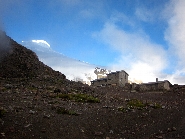
This is part III of the story of the Hamilton Outing Club's winter break trip to Ecuador.
The next day the mountaineering portion of the trek began, and we prepared to hike Cayambe and Cotopaxi, two glaciated volcanoes of 18,996 feet and 19,344 feet respectively. We drove up to the refugio, a lodge for hikers at the base of Cayambe, in two very old (30+ years) Land Cruisers, one of which repeatedly broke down as we jolted along the edge of a steep drop-off over rocks the size of basketballs. Eventually we made it to the top, where, slightly giddy from the altitude, we had dinner and went to bed at 8 p.m.
Three hours later, we got up, ate breakfast, and began our ascent of Cayambe. Because snow is, understandably, coldest at night, it is also harder and less sticky. This makes hiking safer because the snow doesn’t clump up in your crampons, rendering your footing unstable. For a little over an hour we climbed through rocks and volcanic sand until we reached the head of the glacier. There, we put on our crampons and joined up with our rope teams, each of which was led by an experienced Ecuadorian guide. Because the slopes of such mountains are so steep and crossed with hidden crevasses, roping together was a necessary precaution.
It was a long, dreamlike haul up the mountain. We went slowly, taking one step at a time, to save our energy, but we had slept so little and were so high up that we were very tired. The slope was so steep that sometimes I would look up and see headlamps that seemed to be directly above me. When we stopped, we quickly got cold, and although we knew we should eat, no one wanted to because the altitude took away our appetites and made our stomachs turn.
Daylight slowly broke over us and saw us through the final two hours to the summit. Near the top, we passed under a glittering overhang of ice and came to a dead end – a wall of snow. Using his ice axe, our guide began to climb straight up it. For a moment we were shocked that we were expected to follow, but it turned out not to be as impossible as it looked. At the top of this wall, there was only a short 20 minutes to the summit, but it felt like ages, and we all sat down in exhaustion the moment our guide announced, “the summit!”
After a rest, we dragged ourselves up to look around at the view, which was partially obscured by clouds but somewhat visible. The magic of being at 19,000 feet as well as at the highest point on the equator was somewhat lost on us at the moment, and we shortly headed back down. It was a long, treacherous lurch down the slope. At one point, the snow opened under our guide, who suddenly dropped into a shallow crevasse; while too shallow to be dangerous, this incident was somewhat startling. Snow kept balling up in our crampons and causing us to trip and fall. Worst of all, a few of us completely forgot to put on sunscreen…and we certainly suffered the effects of that later on.
After a day of rest and many games of cards, we headed back out to the refugio at the base of Cotopaxi. The plan was much the same as it had been for Cayambe, but this time, due to vicious winds and altitude sickness, only three of our number braved the crevasses and snow-bridges to achieve the summit.
The mountaineering portion of our trek had come to a close, and it was time for the highly anticipated rainforest segment of our journey.
Related:
Posted February 2, 2011
